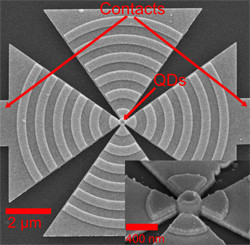Phototechnology that hits the bull's eye
Novel materials with unique properties drive the evolution of numerous fields and the development of exciting new devices. A new class of materials, plasmonics, exploits the interaction of light with composites consisting of metals and dielectrics to produce optical properties not seen in nature. These metamaterials are expected to enhance the performance of many optoelectronic devices but applicability has remained elusive. The EU-funded project 'Plasmonically-enhanced quantum dot photodetectors' (PEQUPHOT) was launched to break the barrier and demonstrate the potential. It combined two novel technologies, a type of nanostructured (quantum dot) photodetector and a plasmonic antenna. The team chose photodetectors as detection of optical signals is critical to numerous applications. Low-cost, solution-processed quantum dot photodetectors are gaining interest. However, there has been a trade-off between speed and sensitivity. Minimising the electrically active area increases speed but the optically active area must be large enough to capture a lot of photons. Plasmonic antennae concentrate light at the nanoscale, providing the impetus for the project. Scientists employed a plasmonic bull's eye structure that consists of periodically arranged concentric metal grooves. The grooves concentrate and focus the light into the centre or bull's eye, enhancing transmission through a sub-wavelength hole there. They thus reduced the electrically active area of the photodetector but maintained its optically active area with a plasmonic antenna. Experiments demonstrated that the performance of the quantum dot photodetectors was improved. In fact, the plasmonic bull's eye photodetector outperformed both references, one with the electrical area as large as the optical area of the plasmonic antenna and one with the optical and electrical area as small as the electrical area of the enhanced structure. PEQUPHOT has provided compelling new evidence that plasmonics can enhance the performance of optoelectronic devices. The project has made a major contribution to a growing field and strengthened the EU's competitive position.
Keywords
Photodetector, optoelectronic, quantum dot, plasmonic antenna







